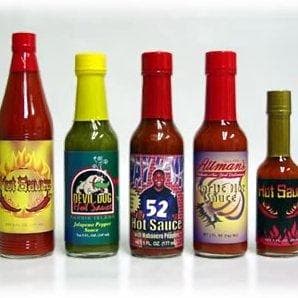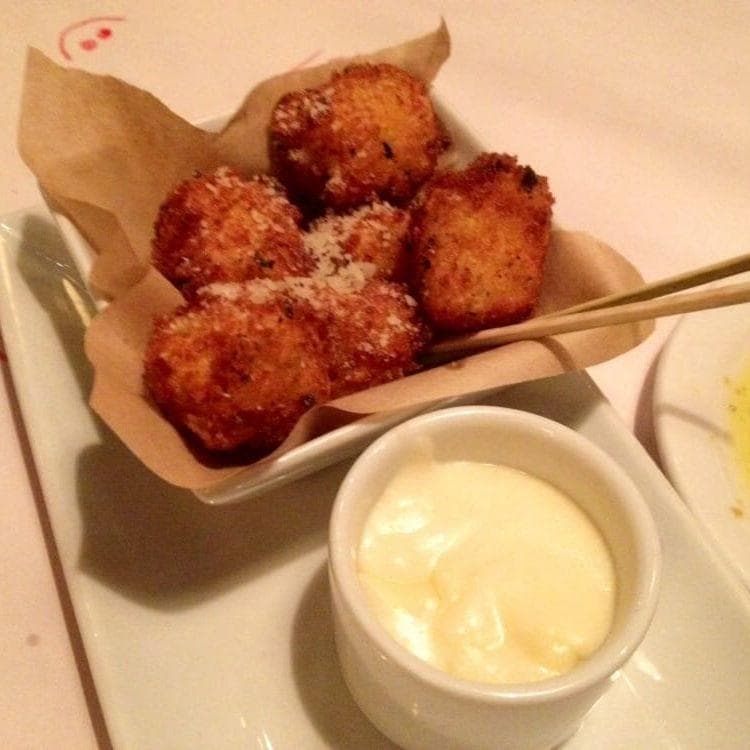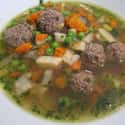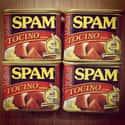-
(#8) 'One Pot' Meals Were A Symbol Of Patriotism In WWII Germany
While food has proven to be a powerful tool for reclaiming power and identity, it's important to acknowledge the ways it has also been used for cultural deconstruction. While the major methods employed to subjugate, demean, and decommission "undesirable" groups during the Third Reich are obvious, over 20 million people lost their lives as a direct result of malnutrition and starvation.
The term "useless eater" was used to describe groups and individuals who were unfairly deemed unproductive and therefore a drain on society. Though "eater" is used symbolically in this case, Germany's far-right was incredibly restrictive in their dietary rationing, and even people they considered "rightful citizens" were subject to literal starvation.
Soldiers and higher-ups ate quite well, meanwhile, helping themselves to the re-appropriated assets of their subjugated targets. Civilians were reduced to eating bread, potatoes, and undesirable factions of meat.
One of the best examples is the Eintopf, which translates to "one pot," a stew or a casserole. Germans were encouraged to view the Eintopf as a social ritual and symbol of national identity. The Eintopf was fuel-efficient, inexpensive, and could feed many people at once. Of course, Germany's leader wasn’t actually eating it.
-
(#3) Spam Became A Staple In The Philippines Because Of Unprecedented American Fears
While canned meat carries a class stigma in the United States, its impact and utility cannot be denied. Spam is often mocked as "mystery meat;" it's the namesake of unwanted web junk mail, after all.
If you are seriously wondering what Spam is, be assured that its ingredients are less distressing than what's in hot dogs. Spam is made of pork shoulder, ham, water, salt, potato starch (to bind the materials into their recognizable loaf shape), sugar, and sodium nitrite.
Invented in 1937, Spam became internationally popular during WWII. The invention of a shelf-stable, sealed protein was novel and practical for soldiers. Spam was delivered to American occupations all across the globe, and it had an unexpected cultural impact on the Philippines, which was colonized by the United States from 1899 to 1946.
Afraid of contamination, American military personnel stationed in the Philippines did not eat native food. Instead, they imported their own vacuum sealed foods, and Spam was a popular menu item. While the generally well-to-do American soldiers and politicians viewed the canned meat as an inconvenience and a degradation of their values, it was considered a luxurious import by Filipinos.
After the Philippines gained independence from the United States, Spam became a cultural mainstay in the Filipino diet. Some tasty examples of the unique Filipino preparations of Spam include Spamsilog - a Spam-infused rendition of the classic Filipino breakfast of sinangag (garlic fried rice) and itlog (egg). There is even a special Tocino Spam, replicating the flavor of Filipino-style cured bacon.
-
(#1) Freed Black Women In 19th Century America Used Fried Chicken To Become Successful Entrepreneurs
Fried chicken plays a complicated role in American history. Since the early 20th century, the universally beloved dish has been a tool of objectification and stereotyping. While this negative association remains difficult to shake over a century later, fried chicken is also a symbol of freedom, independence, and financial security.
According to race folklorist Claire Schmidt, the stereotype originated from the 1915 film The Birth of a Nation, which dramatizes the founding of the Ku Klux Klan in a positive, sensationalized light. In the film, white actors play Black politicians behaving inappropriately on the job, kicking their feet up onto the desk and eating fried chicken.
"It's a food you eat with your hands, and therefore it's dirty. Table manners are a way of determining who is worthy of respect or not,” says Schmidt. The relaxed consumption of the dish also happens to be the reason fried chicken is so beloved in American culture, however. Chickens are inexpensive and easy to raise, which makes them a useful staple food. Fried chicken keeps well and can be eaten without utensils. It's tasty and convenient.
Utility aside, it also has a righteous history. In the years during and following the abolition of slavery, Black women seeking economic independence tapped into a lucrative market: the rapidly expanding rail system. In the absence of dining cars, there was a need for quick travel food. The women, known as "carrier waiters," would cook fried chicken, biscuits, and other baked goods that would still be okay after long periods of time. In some areas, the fried chicken operation was so popular that travelers would plan their route around their favorite carrier waiters.
In modern society, fried chicken transcends race, class, and geographical lines across America. From the $5 Fill-Up to bougie chicken and waffle gastropub concepts, fried chicken is a culinary staple throughout the nation.
-
(#10) Monterey Jack Cheese Is Named After A Western Settler Who Took Land From Spanish Missionaries
Before the Mexican-American conflict, Spanish-Franciscan fathers established a mission in Monterey Bay, CA. The rest of the land in the area was occupied by Spanish and later Mexican farmers, who operated under the ranchos land grant system. Cattle was a particularly lucrative Spanish import that generated one of the area's most valuable delicacies, a creamy white cheese called "queso blanco."
Following the annexation of California to the United States at the end of the fighting in 1848, a deluge of gold-hungry settlers poured into the new state, including David Jack, a Scottish land speculator. Soon after the Gold Rush began, the newly minted Monterey city officials began to process the land claims of the ranchos owners and the missionaries, who were theoretically going to maintain ownership of their properties.
In 1853, after years of bureaucratic stalling and fumbling, the United States Land Claims Commission put 29,698 acres of land previously owned by the ranchos up for auction. At this point, the former denizens of Monterey were financially exhausted and unable to recuperate, so David Jack and the attorney meant to represent Monterey purchased the property for $1,000.02.
Though it was originally created by the Franciscan fathers who preceded him, Jack realized that he could use his newly acquired cattle ranches and dairies to make money off queso blanco. He marketed it as "Jack’s Cheese" and the popular product eventually became known as Monterey Jack.
-
(#7) Milk Bars Came Out Of Rationing In The Polish People's Republic
During the later years of the Eastern Bloc era, Poland's debt became untenable. Due to a bungled reparations deal with Germany at the end of WWII, Poland never fully recovered financially and was left with no other choice than to obtain credit from the West throughout the 1970s. By the early 1980s, it became clear to the Western creditors that Poland was still struggling to make ends meet and could not pay off the loan, which had soared to $16 billion by 1982.
During this period, Polish citizens had to abide by strict rations on basic household goods, and foods previously taken for granted were no longer available. As a result, a new culinary culture emerged, and most families ate at home, in canteens, and in "milk bars" - inexpensive cafeterias that served simple dairy-based entrees.
Popular milk bar offerings included every configuration of egg one could imagine, pancakes, dumplings, and soups. While many of the food traditions of the era disappeared in 1989, milk bars are still considered a crucial and important part of Polish history. Retaining their Eastern kitsch retro style, they remain a valuable part of the Polish tourism industry.
Milk bars even play a crucial atmospheric role in A Clockwork Orange.
-
(#9) Turkish Cuisine Is A Fusion Of Cultures That Conquered Istanbul
The eclectic nature of the Turkish palate illustrates the turbulent history of the region. Heavily influenced by the numerous upheavals and changes in national identity, Turkish food is best described as an amalgam of Central Asian, Balkan, Eastern European, and West Asian influences. Each empire that resided in modern day Turkey brought their own styles of cooking, and modern Turkish cuisine is a reflection of the region's rich and complicated past.
The Hittites, the original nomadic settlers of Anatolia, the region that would later become Turkey, were fond of yogurt, cold meats, bread, and honey. Ayran, a salted yogurt beverage still popular in West Asia today, came from this era of Turkish history.
Between the 8th and 12th centuries, Islamic influences became prevalent as Arabs gained power over Turkey. The Silk Road trade route between East Asia and Europe was in full swing, and Turkey was centrally located. Documented and recovered recipes from this time reflect the arrival of spices from the East. One memorable dish to come from the Islamic influence is the manti, or the Turkish version of a dumpling. It is typically made with spiced lamb or beef wrapped in dough and steamed, topped with yogurt, garlic, and mint. Other accouterments may include butter, sumac, or red pepper - another Turkish staple.
During the Ottoman Empire, Turkish food was shaped mainly by Persian techniques, though it still retained many of its previous attributes. Due to the expansive nature of the Empire, Balkan, Mediterranean, and North African foods were rolled into the Turkish repertoire. One key difference between Turkish foods and their comparable Persian counterparts is the separation of salty and sour flavors from sweet flavors, and there is overall less spice.
In modern times, the most internationally ubiquitous Turkish food is the döner kebab, a derivative of the Ottoman rotisserie style of meat preparation. A savory-seasoned meat is prepared on a vertical rotisserie, shaved, wrapped up in a dürüm (a thin flatbread), and topped with assorted vegetables and sauces.
New Random Displays Display All By Ranking
About This Tool
During the development of human civilization, many innovative foods were born. Food custom is a compound custom under the influence of many factors, especially subject to the dual constraints of economic and nature. In famine or war periods, the people were at a loss for the preservation of perishable foods such as fresh vegetables and seafood, forcing more food innovations to emerge.
The random tool introduced random 10 innovative foods that were born in some cultural tragedies, few people know that spam is a staple in the Philippines because of unprecedented American fears, here is more information about other foods.
Our data comes from Ranker, If you want to participate in the ranking of items displayed on this page, please click here.
















